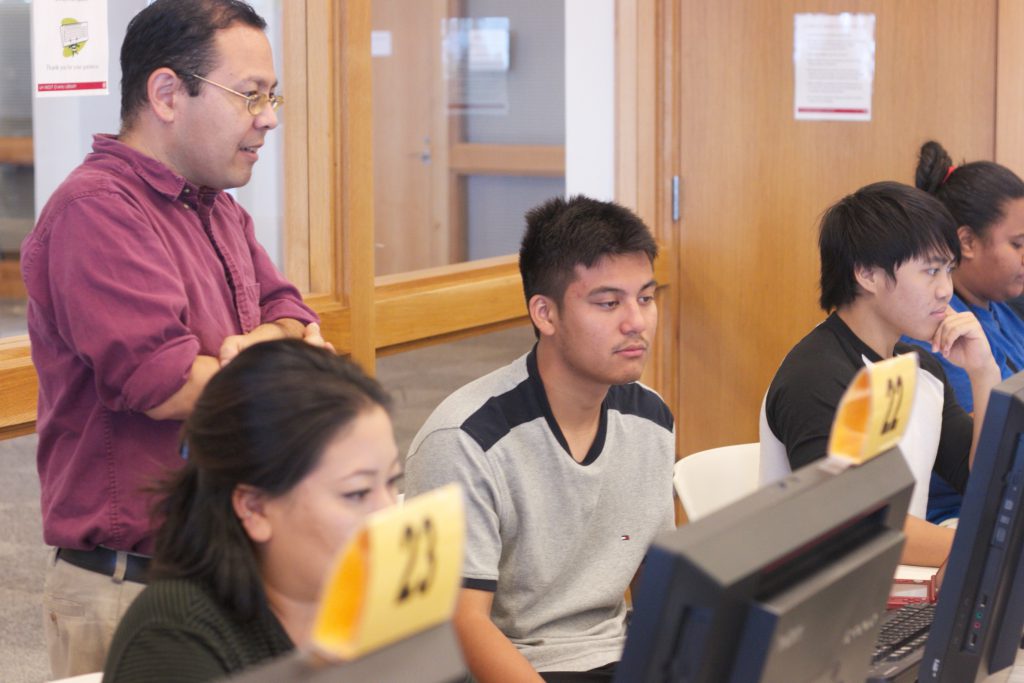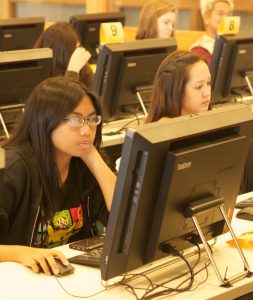
Summer Bridge gave students a chance to hone their math skills
UH West Oʻahuʻs efforts to better prepare incoming freshman for the rigors of college paid off this summer with more high school students than ever attending Summer Bridge programs.
Dozens of high school graduates were on campus this summer to take part in programs that help smooth the sometimes jarring transition from being a high school graduate to college student. The transition was helped through four Summer Bridge programs that help students get acquainted with taking university courses, the campus, and resources available to them. Additionally, high school students attended courses under a program operated under a partnership with the State Department of Education.
“It’s been exciting,” said Lokelani Kenolio, Director of the Noʻeau Center, which hosted 48 Math Summer Bridge students. “It’s wonderful to have more students on campus.”
Summer Bridge programs typically are designed to enhance a student’s chances for success. They vary by institution, but can include an in-depth orientation to college life and resources available to them, academic advising, skills training and coursework. At UH West Oʻahu, the Summer Bridge students are familiarized with different support services on campus and develop a level of comfort with faculty and staff.
Research on summer bridge programs is mixed, but an article in the American Journal of Education that examined national data found such programs are beneficial. The authors concluded bridge students have a higher graduation rate after six years and the programs may help students address math and English skill deficits and avoid remedial classes disliked by freshman.
Four bridge programs were offered during the 2017 Summer Academy, one of UH West Oʻahu’s signature programs that help local high school graduates get an early start on college life. Three of these were grouped under Ke Ala Kauwela, a program aimed at helping incoming freshman from the Waiʻanae Coast. This included:
►E Holomua a ʻOnipaʻa. 2017 graduates of Nānakuli High and Intermediate School, Waiʻanae High School or Kamaile Academy engaged with faculty, staff, and others throughout the May 30 to Aug. 9 program while taking college-credit courses and participating in Service Learning projects in the community. Up to $1,500 in student employment income was available.
►ʻIke ʻAi Pono Summer Program. This was available to first-time college freshman from the Waiʻanae Coast who had been accepted at UH West Oʻahu for the Fall 2017 semester. The program, running from May 25 to July 21, integrated pathways in Education and Sustainable Community Food System concentrations for students interested in careers as agroecologists or teachers. Students earned four credits for taking EDUC120/SCFS120: Āina and place-based education and SD 100: University Experience, participated in Service Learning, and were paid a $1,500 stipend for completing the program.
►ʻIke Mauli Ola. This was available to first-time college freshman from the Waiʻanae Coast who had been accepted at UH West Oʻahu ʻIke Mauli Ola pre-nursing program for the Fall 2017 semester. Students received college credit, completion of Certified Nursing Aide training, and a $1,500 stipend for the program running from May 25 to July 21.
Additionally, there was a Math Summer Bridge for college freshmen that included a five credit college algebra course with embedded tutoring and peer coaching support services. The 8-week program that began June 1 with students engaging with faculty and staff as well as learning about campus resources.

Summer Bridge students at work
There were many more Summer Bridge students this year because of extensive partnerships with the Hawaiʻi Department of Education, GEAR UP (Gaining Early Awareness and Readiness for Undergraduate Programs), UH West Oʻahu’s Pueo Scholars, and Kamehameha Schools, said Dr. Melissa Saul, director of the Institute of Engaged Scholarship and Project Director of the PIKO project.
Saul said UH West Oʻahu also has been working with local schools and Hawaiian Charter Schools to increase the college-going rates and college-readiness skills. This includes developing pathway programs focused on health careers, education and sustainable community food systems.
“The programs help students learn how to navigate college successfully and how to access services on campus,” said Saul. “We have found that students who participate in summer programs are more likely to attend college and be retained from their freshman to sophomore year.”
Students also get exposed to unique experiences. Some of the Summer Bridge students could enroll in Math 100H, Survey of Math through Hokuleʻa, which including sailing on Hikianalia, Hokuleʻa’s sister voyaging canoe.
Math Summer Bridge students were exposed to workshops on subjects ranging from time management to financial aid and got to know student tutors available to them. ʻIke Ola Summer Bridge students also were exposed to the IMUA curriculum focused on the Hawaiian values of ʻIke (knowledge), Mālama (to care for), Ulu (to grow), and Aloha (to love and respect), said Hōkū Talo, ʻIke Ola coordinator.
Talo said the increase in students is also the result of hard work by UH West Oʻahu in developing pathway programs and in establishing relationships with students during their high school years. She said relationships are key with many families on the Leeward Coast, especially when it comes to those whose sons or daughters who are first-generation college students.
“By establishing a relationship with the students, the parents end up trusting you as an advisor/recruiter to ensure the success of their child,” said Talo, adding that she believed the summer programs were increasing the college-going rate of students from the Leeward Coast.
In addition to students from Waiʻanae Coast, the Math Summer Bridge program drew students from Farrington, Leilehua, Waipahu, Kapolei, Campbell, McKinley, High Technology Academy, and other high schools. The turnout is in part to UH West Oʻahu’s outreach to schools, said Kenolio. She said the students generally loved the experience, and that it may provide other dividends for UH West Oʻahu — some Summer Bridge students who were considering attending community college in the fall were now contemplating a change to the university.
